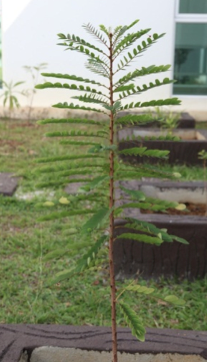Naga Buana
| Naga Buana | |
| Scientific Name | Phyllanthus pulcher Ex Muell. Arg |
| Family | Euphobiaceae |
| Synonyms | Diasperus pulcher, Epistylium pulchrum, Phyllanthus asteranthos |
| Common Name | Saga buana, pokok kayu putih, semelit |
 |
{slider=General Appearances}
Shrub up to 1.5 mhigh. Distichous leaves. Obliquely oblong to ovate-oblong in shape. Inflorescence a bisexual axillary fascicle, has ciliate bracts at the base
{/slider}
{slider=Chemical Contents}
Bis(6-methyl)phthalate, phyllanthal-A and 3,4-dihydroxy-5-methoxy-3’,4’,4’-trihydroxyoxepino-chromene-2-one stigmast-5-en-3-ol-oleate, disobutyl adipate, β-sitosterol, 7-tridecanone and β-sitosteryl-β-D-glucopyranoside 12(13)-dehydro-3α-acetoxyolean-28-oic acid and lupanol acetate 3 α-acetoxy-25-hydroxyolean-12-en-oic acid, glochidone and glochidonol (Bagalkotkar et al 2000)
{/slider}
{slider=Traditional Uses}
Decoction used as an eye wash, nasal ulcers, abscesses, pruritus, fever and renal problems in children. Decoction of the whole plant can relieve stomachache. Paste of the leaves or sap is applied on aching tooth for reliave. Decoction of the root is a remydy for hypertension (Globinmed, Kamaruddin et al, 2001).
{/slider}
{slider=Pharmacology}
Cytotoxicity:
Dichoromethane extracts of the aerial parts showed cytotocity on MCF-7 cells. The extract content were Stigmast-5en-3-ol-ol3ate, bis(6-methylheptyl)phthalate, phyllanthal-A and B-sitosteryl-B-D-glucopyraniside.Phyllanthal –A active against to DU-145. 3α-acetoxy-25-hydroxyolean-12-en-28-oic acid showed cytotoxicity against MVF-7 and DU-145.(Ismail M et al 2012, Globinmed).
Anti-HIV-1 reverse transcriptase activity
The extract showed activity against HIV-RT at IC50 of 5.9 ug/mL.(Eldeena et al 2010)
Anti-angiogenic Activity
The extract at contration at 100 ug/ml showed an inhibition of 78.8 % against rat aortic vascular growth. Only 15.5 % proliferattion on Human umbilical vein (Ng KW et al 2010).
DCM root extracts of P.pulcher exhibit the stongest cytotoxicity activity compared with ethyl acetate and methanol extracts. The extrats contain 5 pentacyclic triterpenes, 3 α-acetoxyl-25-hydroxyolean-12-en 28-oic acid, glochidone, 12(13)-dehydro-3α-acetoxyolean-28- oic-acid, lupanyl acetate and glochidonol (Bagalkotkar G. et al 2011).
[/slider}
{slider=Reference}
Bagalkotkar G. T.S. Chuan, S.I. Khalivulla, A.S. Hamzah, K. Shaari, N. H. Lajis, M.S. Saad & J.Stanslas (2011). Isolation and cytotoxicity of Triterpenes from the roots of Phyllanthus pulcher Wall. Ex Mull Arg. (Euphorbiaceae). African Journal of Pharmacy and Pharmacology Vol 5, (2) Pg 183-188.
Eldeena I.M.S., E.M. Seowam R. Abdullaha & S.F. Sulaiman (2010). In vitro antibacterial, antioxidant, total phenolic contents and anti-HIV-1 reverse transcritase activities of extracts of seven Phyllanthus sp. South African Journal of Botany.
Ismail M., G. Bagalkotkar, S. Iqbal & H. Altine Adamu (2012). Anticancer Properties and phenolic Contents of Sequentially Prepared Extracts from Different Parts of Selected Medicinal Plants Indigenous to Malaysia. Molecules, 17 Pg 5745-5756. www.mdpi.com/journal/molecules.
Kamarudin Md Salleh, A. Latif (2001). Tumbuhan Ubatan Malaysia. Pusat Perkembangan Penyelidikan Universiti Kebangsaan Malaysia Bangi Pg 347.
Ng KW, Salhimi SM, Majid AM, Chan KL (2010). Anti-angiogenic and cytotoxicity studies of some medicinal plants. Planta Med 76(9), Pg 935-940.
http://www.globinmed.com/index.php?option=com_content&view=article&id=84892:phyllanthus-pulcher&catid=718:p
{/slider}
- Last updated on .
- Hits: 3139
